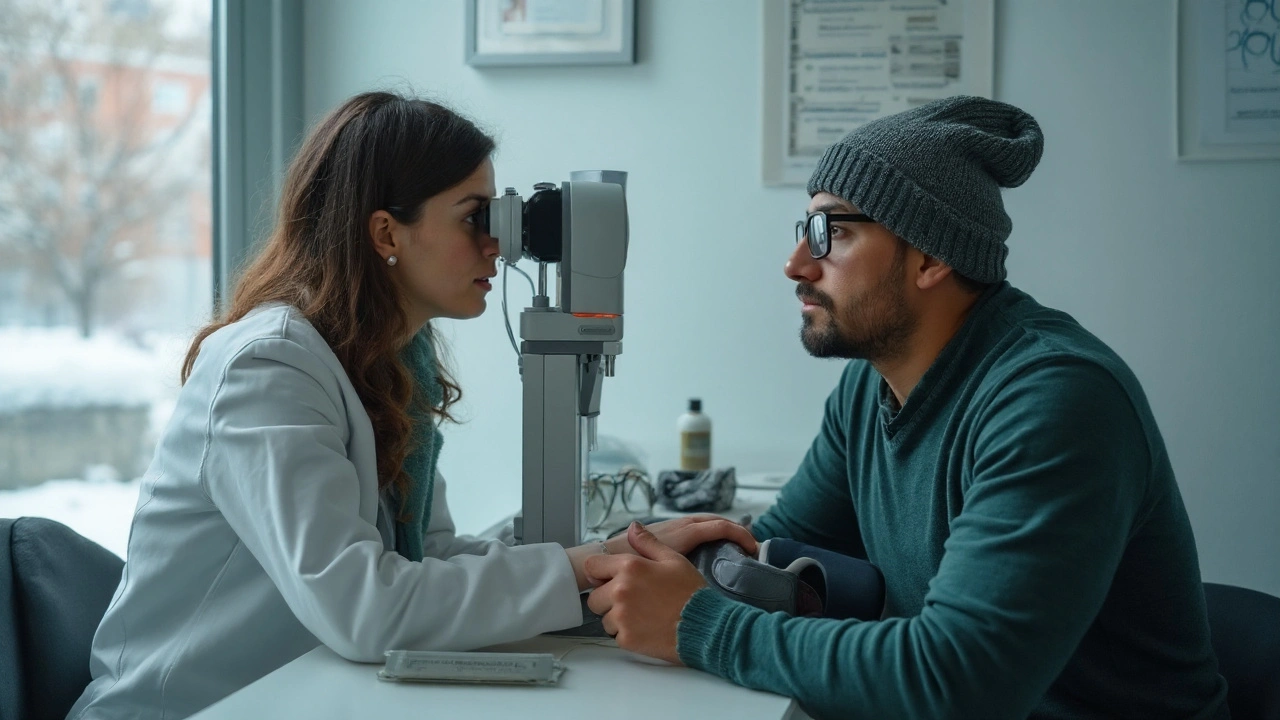It’s easy to get confused about what Hydroxychloroquine actually does. The drug became a headline magnet, but off the front page it’s a steady, useful medicine for autoimmune diseases and a niche option in malaria. If you want the bottom line-what it treats, how to use it safely, and where the risks sit-this guide gives you the clear, practical version doctors explain in clinic.
- What it is: a disease‑modifying antirheumatic drug (DMARD) used for lupus and rheumatoid arthritis; also used for malaria where resistance allows.
- Not for COVID‑19: large, well‑run trials found no benefit for treatment or prevention (WHO, NIH, IDSA).
- Safe dosing rule: aim ≤5 mg/kg/day (actual body weight) to lower eye toxicity risk; most adults take 200-400 mg daily.
- Eye safety: baseline eye check within a year of starting, then yearly after 5 years-or earlier if high risk (AAO/RANZCO guidance).
- Common issues: nausea, diarrhea, rash, itch. Serious but rare: retinal damage, heart rhythm problems (especially with other QT‑prolonging drugs), severe low blood sugar.
What it is, what it treats, and how it works
Hydroxychloroquine (HCQ) is a well‑established medicine in rheumatology. It reduces flares in systemic lupus erythematosus (SLE), improves skin and joint symptoms, and lowers long‑term risks like thrombosis and high cholesterol in people with lupus. In rheumatoid arthritis (RA), it’s often part of a combination plan with methotrexate and sulfasalazine or used alone in milder disease. It also helps some patients with cutaneous lupus and, under specialist care, certain porphyrias at carefully adjusted low doses.
In malaria, HCQ plays a much smaller role than it used to. It can be used for prevention and treatment in regions where Plasmodium species remain chloroquine‑sensitive (think parts of Central America and the Caribbean). In much of Africa and Asia, resistance makes it the wrong tool. Travel clinics and national guidelines (e.g., CDC, WHO, Australian Therapeutic Guidelines) keep updated maps-always check those before relying on it.
How it works: HCQ is a weak base that drifts into the cell’s recycling bins (lysosomes) and gently changes their acidity. That tweak dampens how immune cells present antigens and signals through toll‑like receptors. Translation: it nudges an overactive immune system back toward balance without heavy immune suppression. It also has mild antiplatelet and lipid‑lowering effects, which adds to its long‑term value in SLE.
Timeline: don’t expect overnight results in autoimmune disease. Joint and skin symptoms usually start easing in 4-8 weeks, with full benefit by 3-6 months. That’s normal-and a common reason people stop too early. Stick with it unless you’re having side effects or your clinician advises otherwise.
COVID‑19 myth check: the best evidence from randomized trials (e.g., RECOVERY, SOLIDARITY) showed no benefit for hospitalized patients, outpatients, or as post‑exposure prevention. Major guidelines worldwide advise against its use for COVID‑19.
| Condition | Typical adult dose (HCQ sulfate) | Onset of benefit | Key monitoring | Notes |
|---|---|---|---|---|
| Systemic lupus erythematosus (SLE) | 200-400 mg daily (split or once daily), keep ≤5 mg/kg/day actual body weight | 4-8 weeks; full 3-6 months | Eye screening; weight‑based dosing; consider renal function | Reduces flares and long‑term risks; usually continued through pregnancy |
| Cutaneous lupus | 200-400 mg daily | 4-8 weeks | Eye screening; skin checks | Sun protection and topical therapies often used alongside |
| Rheumatoid arthritis | 200-400 mg daily | 6-12 weeks | Eye screening; disease activity review | Often combined with methotrexate and sulfasalazine |
| Malaria prophylaxis (chloroquine‑sensitive areas) | 400 mg once weekly; start 1-2 weeks before travel, continue during exposure and 4 weeks after leaving | N/A | Check resistance maps; drug interactions (QT) | Not suitable where resistance is present |
| Malaria treatment (chloroquine‑sensitive) | Adult schedule mirrors chloroquine: loading then 3 smaller doses at 6, 24, 48 hours; confirm exact mg with clinician due to base vs salt | Rapid | Cardiac and glucose monitoring if risks present | Use only where confirmed sensitivity exists |
Formulation note: a 200 mg tablet of hydroxychloroquine sulfate contains about 155 mg of “base.” Doses printed in travel medicine references sometimes use “base.” Don’t try to convert on the fly-ask for the exact regimen in the form your pharmacy supplies.

How to use it safely: dosing rules, screening, interactions, and real‑world tips
Before you start, anchor to one idea: the safest dosing strategy is weight‑based. Most issues with retinal toxicity show up at higher doses and long durations. Keep the daily dose at or under 5 mg per kilogram of actual body weight. Example: if you weigh 70 kg, your daily target is ≤350 mg/day; in practice, that’s 200 mg or 400 mg on alternating days, or 200 mg daily as a steady choice. Your clinician will tailor it to your disease and weight.
Getting started-step by step:
- Baseline check: get your weight recorded; share your kidney history; list all your meds (especially anything that affects heart rhythm).
- Eye plan: arrange a baseline eye exam within the first year (earlier if high risk: kidney disease, dose >5 mg/kg/day, tamoxifen use, or pre‑existing macular disease). This visit sets a reference point.
- Pick your dose: most adults start at 200 mg daily with a plan to increase to 400 mg if needed and safe by weight.
- Take with food: it lowers nausea and helps your body handle the dose more smoothly.
- Set expectations: benefits build slowly. Book a review at 8-12 weeks to track symptom change and side effects.
- Long‑term eye screening: start annual screening after 5 years of continuous use, or sooner if you have risk factors.
What does eye screening actually involve? Modern screening uses optical coherence tomography (OCT) and a visual field test focused on the central retina. Those detect early changes before vision is affected. The American Academy of Ophthalmology and Australia’s RANZCO recommend this approach because catching toxicity early is what keeps vision safe while staying on a helpful drug.
Lab checks: HCQ is kinder to the liver and bone marrow than many DMARDs, so routine frequent blood tests aren’t always needed. Many rheumatologists get baseline bloods (full blood count, liver and kidney function) and repeat if clinically indicated, or every 6-12 months if you’re on other meds. If you have kidney disease, dosing and eye risk need extra attention.
Key drug interactions and what to do about them:
- QT‑prolonging medicines: combining with drugs like amiodarone, sotalol, some antipsychotics, or macrolide antibiotics (e.g., azithromycin) can raise rhythm risks. If you must combine, your prescriber may check an ECG and electrolytes.
- Digoxin: HCQ can raise digoxin levels. If you take digoxin, you’ll likely need a level check and sometimes a dose change.
- Diabetes meds and insulin: HCQ can enhance glucose‑lowering effects. Watch for hypos-have a plan to adjust doses.
- Cyclosporine and tacrolimus: blood levels can rise. This is specialist territory; expect closer monitoring.
- Antacids: they can reduce HCQ absorption. Take antacids and HCQ at least 4 hours apart.
Who shouldn’t take it or needs extra caution:
- Known hypersensitivity to 4‑aminoquinolines (e.g., chloroquine).
- Pre‑existing macular disease or severe retinal disease-needs an ophthalmologist’s input.
- Severe kidney disease-dose and eye risk need tailoring.
- Psoriasis or porphyria-may flare; specialist advice required.
- Myasthenia gravis-can worsen muscle weakness in some cases.
Pregnancy and breastfeeding: good news here. Continuing HCQ in pregnancy for lupus/RA is standard and supported by EULAR and obstetric guidelines because it cuts flares and is not linked to birth defects. It’s compatible with breastfeeding. If you’re planning pregnancy, talk timing and dosing with your rheumatologist well before you try.
Malaria decisions-quick rules of thumb:
- Going to a chloroquine‑sensitive region? HCQ 400 mg weekly is a valid option if you tolerate it well.
- Going to a resistant region (most of Africa, much of Asia)? Choose atovaquone/proguanil, doxycycline, or mefloquine instead. HCQ won’t protect you there.
- Start prophylaxis 1-2 weeks before you go, take it on the same day each week while away, and keep taking it for 4 weeks after you’re back.
- Still get bitten a lot? Drug + bite prevention is the combo that works: long sleeves, DEET or picaridin repellent, permethrin‑treated clothing, and bed nets.
Everyday pro tips patients find useful:
- If 400 mg at once upsets your stomach, take 200 mg twice a day with meals.
- Set a daily alarm. Missed doses are the most common reason people think it “isn’t working.”
- Avoid unnecessary sunburn. HCQ can make skin a bit more sensitive in some people, and lupus skin benefits from good sun habits anyway.
- Dark skin patches on shins or face can happen over time. It’s harmless cosmetically, but tell your clinician so it’s documented.

Side effects, red flags, myths, mini‑FAQ, and what to do next
Most people tolerate HCQ well. But you deserve a clear picture of what to watch for and how likely things are.
Common, usually mild:
- Stomach upset: nausea, cramps, diarrhea-often improves by taking with food or splitting doses.
- Skin reactions: rash or itch; darkening of skin or nails with long‑term use.
- Headache, dizziness-usually temporary.
Less common, more serious (call your clinician promptly):
- Visual symptoms: difficulty reading, missing spots in central vision, changes in color perception. These are the red flags for retinal issues.
- Heart rhythm symptoms: palpitations, fainting, new chest discomfort-especially if you’re on other QT‑prolonging drugs or have low potassium/magnesium.
- Severe low blood sugar: sweating, confusion, shakiness if you’re also on diabetes medications.
- Muscle weakness that doesn’t match your usual pattern-rare but worth checking.
What does the evidence say about risks?
- Retinopathy risk stays low in the first 5 years at ≤5 mg/kg/day. After that, risk rises with time, higher doses, kidney disease, and tamoxifen. Modern screening detects changes earlier (AAO 2016/2021 guidance; RANZCO echoes this).
- Cardiac events are rare but real-especially with drug combinations that affect the QT interval. That’s why prescribers screen your medicine list.
- G6PD deficiency: unlike some antimalarials, HCQ hasn’t shown clinically significant hemolysis at standard doses in most studies; routine screening for G6PD isn’t required for HCQ alone.
Myths to retire:
- “It’s an immune suppressant.” Not quite. It modulates immune activity without deep suppression, so vaccines remain effective and infection risk isn’t notably increased.
- “Eye damage is inevitable.” Most people never develop retinal toxicity if they keep to safe dosing and attend screening.
- “It works for any viral infection.” No. It failed rigorous COVID‑19 trials and isn’t used for other viral illnesses.
Mini‑FAQ
- How long should I stay on it for lupus? Many people stay on it indefinitely because it prevents flares and has long‑term benefits. Stopping often leads to flares.
- Can kids take it? Pediatric rheumatologists use weight‑based dosing in juvenile lupus. Eye screening rules still apply.
- Can I drink alcohol on it? Light to moderate alcohol is usually fine, but if you’re on other liver‑affecting meds, ask your clinician.
- Is it safe with methotrexate? Yes, they’re commonly paired in RA, with different monitoring needs.
- What if I miss a dose? Take it when you remember the same day. If it’s almost time for the next dose, skip the missed one-don’t double up.
- Can I stop suddenly? You can, but don’t do it without a plan; symptoms may flare over weeks.
- Do I need blood tests often? Usually not for HCQ alone. Your other meds may drive the lab schedule.
Practical checklists
Before you start
- Confirm your indication (SLE, RA, or chloroquine‑sensitive malaria plan).
- Weigh yourself (or get weighed) to set a safe daily max.
- List your medicines, including over‑the‑counter and supplements.
- Book a baseline eye exam date (within the first year-or sooner if high risk).
- Set a reminder for your 8-12 week symptom review.
Day‑to‑day checklist
- Take with food.
- Stick to one daily time or split twice daily if queasy.
- Use a pillbox or phone reminder to avoid missed doses.
- Tell your pharmacist you’re on HCQ-helps them check interactions.
“Call now” triggers
- New visual changes-don’t wait for your next appointment.
- Fainting, severe palpitations, or chest pain.
- Repeated low blood sugars if you’re on diabetes meds.
Travel‑specific quick guide (for Australians, but applies broadly)
- Check current malaria maps via your travel clinic; resistance changes over time.
- If you’re headed to chloroquine‑sensitive areas (e.g., Haiti, parts of Central America), HCQ 400 mg weekly is an option if you tolerate it.
- For most of sub‑Saharan Africa or Southeast Asia, pick atovaquone/proguanil or doxycycline instead. HCQ won’t protect you there.
- Start 1-2 weeks before you leave; continue for 4 weeks after return.
- Add bite avoidance: repellent (DEET/picaridin), treated clothing, nets.
Credible sources behind this guide: major rheumatology and ophthalmology recommendations (EULAR 2019/2023 for SLE; American Academy of Ophthalmology 2016/2021 screening statement; RANZCO guidance), large COVID‑19 trials (RECOVERY, SOLIDARITY), and national malaria guidance (WHO, CDC, Australian Therapeutic Guidelines). Clinicians align with these when they set dosing and monitoring.
Next steps / troubleshooting
- If you feel no change by 8-12 weeks: don’t write it off yet. Many people need 12-16 weeks for joint gains. Your clinician may tweak the dose (within weight limits) or add a partner drug.
- If nausea is a deal‑breaker: try splitting the dose 200 mg twice daily with meals; ginger tea or simple anti‑nausea strategies can help. If it persists, talk alternatives.
- If you’re starting pregnancy or IVF: keep taking HCQ unless your rheumatologist advises differently. It stabilizes disease and is considered safe.
- If you’re prescribed azithromycin or another QT‑prolonger: tell the prescriber you’re on HCQ; they may switch the antibiotic or check an ECG.
- If your kidney function drops: your eye risk rises; your team may lower the dose and bring eye screening forward.
- If you develop vision symptoms: stop the drug and get urgent ophthalmology advice. Early detection often prevents lasting damage.
- If travel plans change to a resistant region: swap your malaria plan-don’t rely on HCQ where it doesn’t work.
You’ve now got the plain‑English version of how to use this medicine smartly: right dose, right eyes, right expectations. That’s how people get the benefits-less pain, fewer flares, safer travel-without unwanted surprises.


Kevin Cahuana
Hey, I get how overwhelming all those dosing rules can feel, but you’re not alone in navigating this.
Danielle Ryan
Wow!!! The pharma giants definitely didn’t want you to know that they’re secretly sprinkling extra QT‑prolonging chemicals into every batch!!!
Deb Kovach
Hydroxychloroquine remains a cornerstone DMARD for lupus and rheumatoid arthritis when used correctly. The key to safety is strict weight‑based dosing-no more than 5 mg per kilogram of actual body weight per day. For a 70 kg patient that translates to a maximum of 350 mg daily, which most clinicians achieve with 200 mg or 400 mg regimens. Baseline ophthalmology assessment should be performed within the first year of therapy, especially if any risk factors exist. After five years of continuous use, annual retinal screening with OCT and visual field testing becomes essential. Most adverse effects are mild: nausea, diarrhea, and occasional skin rash can often be mitigated by taking the drug with food. Serious concerns such as retinopathy or cardiac conduction abnormalities are rare when dosing guidelines are followed. If you are on other QT‑prolonging medications, your physician will likely obtain an ECG and monitor electrolytes. Patients with renal impairment may need dose adjustments and earlier eye examinations. Pregnant patients with lupus can safely continue hydroxychloroquine, as it lowers flare risk without teratogenicity. Breastfeeding is also considered safe; the drug passes in low amounts into milk. For malaria prophylaxis, remember it only works in chloroquine‑sensitive regions; always verify resistance maps before traveling. The typical prophylactic regimen is 400 mg once weekly, started one to two weeks before departure and continued for four weeks after return. If you experience visual disturbances such as blurred vision or dark spots, stop the medication immediately and seek urgent ophthalmology care. In summary, adherence to weight‑based dosing, regular eye monitoring, and awareness of drug interactions will maximize benefits while minimizing risks 😊.
Robyn Chowdhury
Thank you for the comprehensive overview; the emphasis on weight‑based dosing and ophthalmic surveillance aligns well with current guidelines. 😊
jana caylor
I really appreciate the practical checklists; they make it easy to remember what to do before starting hydroxychloroquine and during follow‑up visits.
Vijendra Malhotra
Listen, the facts are clear – if you ignore the dosing limits you are courting disaster, and no one should let that happen.
Nilesh Barandwal
Stay positive – the drug works wonders when you respect the rules!!!
LEE DM
Remember, everyone's situation is unique, so always discuss your personal risk factors with your healthcare team before making changes.